Hello,
Ratatouille is a traditional French meal consisting of common garden vegetables. I make mine with eggplant, zucchini, tomatoes, bell peppers, onion, and garlic. Seasonings include Herbes de Provence, fennel seeds, and bay leaves. I usually eat it as a stand-alone dish or over rice, but it works well with macaroni. View the recipe here.
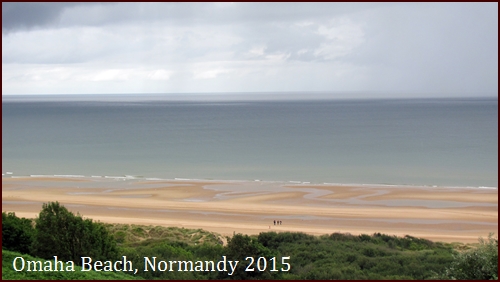
In August, Dominique, myself, and her parents, visited Normandy, France, site of the WWII D-Day invasion which began on June 6, 1944. Dominique’s mother, who is French, was a teenager living outside Paris during the German occupation. She thanked me numerous times for liberating France even though I was not alive at the time. Her family was fortunate to have relatives living in the countryside who helped them out with food from the farm because market food was scarce. Dominique’s father, who is Swiss, told us about strict food rationing implemented in Switzerland at that time. His family had a neighbor who gave them eggs in exchange for kitchen scraps which were fed to the neighbor’s pig.
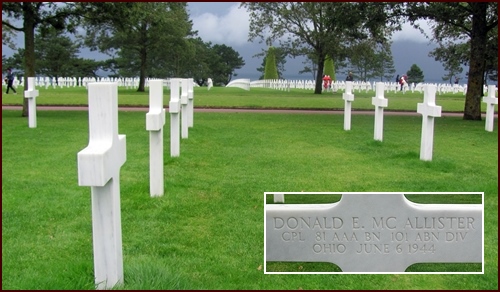
No direct relatives of mine fought in WWII – my father was too young and my grandfather too old. Dad was in eighth grade at the time. He told me that when his teacher went off to the war, the replacement teacher put my father in charge of writing the news about the war on the blackboard each day. Before we left for Normandy, I researched my family names – McAllister, Owens, and Kelson – to see if any soldiers with those names were buried in the Normandy-American Cemetery. I found them all, and while not my kin of recent times, I imagine that I share a genetic link with them from an earlier time in Scotland. Visiting their graves allowed me to pay respects to those individual men amongst the thousands interred there under perfectly aligned rows of granite crosses across 172 acres of manicured lawn above Omaha Beach. Their rest in peace was hard-fought.
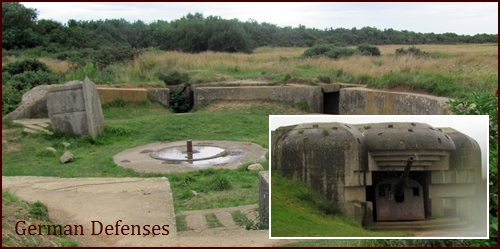
Our hotel in Crépon was near Juno Beach where the 3rd Canadian Infantry Division landed. Juno Beach was between Gold and Sword Beaches where the British landed. The Americans landed on the westernmost Omaha and Utah Beaches. Over the course of five days, we visited the cemetery, beaches, and several museums which exhibited the machinery of war and explained the engineering feats required to launch the attack against every conceivable German defense. Inspecting the remains of the thick concrete bunkers above the beaches, I, along with all the other visitors, pondered quietly what those courageous liberators faced on D-Day. Corporal Donald E. McAllister, 81st Anti-Aircraft Battalion, 101st Airborne Division, arrived by sea on June 6th. He was killed that same day. His comrades fought on selflessly all the way to Paris – and we are forever grateful for their sacrifices.
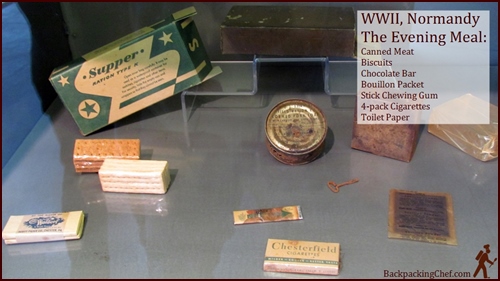
The soldiers did not dine on ratatouille in those days. They carried K-rations which consisted of three boxed meals per day – breakfast, dinner, and supper. Each meal contained canned meat or cheese, biscuits, a powdered beverage like orange drink or instant coffee, a sweet item like candy, gum, chocolate, malt and dextrose tablets, sugar, and four cigarettes. Total calories per day: 2,830 - 3,000.
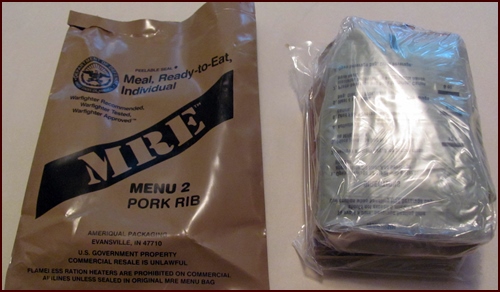
My son-in-law, Christopher, served in the Marines recently. He gave me a modern day MRE: Meal, Ready-to-Eat, because I was curious if combat fare had improved. Each meal is packaged in a plastic bag which is packaged inside a thicker plastic bag. It seemed bulky and heavy at one pound eight ounces, but Chris says they take the meals out of the packaging when they load up their gear. One technological advancement is a plastic heater bag with a chemical powder pouch inside which creates heat when it comes into contact with a small amount of water. All the soldier has to do is slide the sealed meal (no extra water required) into the heater bag, add an inch of water to activate the chemical reaction, close the bag and put it back in the box it was packaged in to hold in the heat for ten minutes. The military recommends soldiers on maneuvers or in combat eat three MREs per day. The one I dissected had 1,395 calories. The meal consisted of Potato Cheddar Soup, Imitation Pork Rib
Meat, Sugar Cookies, Spiced Cider Powdered Drink, Peanut Butter, Blackberry Jam, BBQ Sauce, Crackers, and Tropical Punch Powdered Drink.
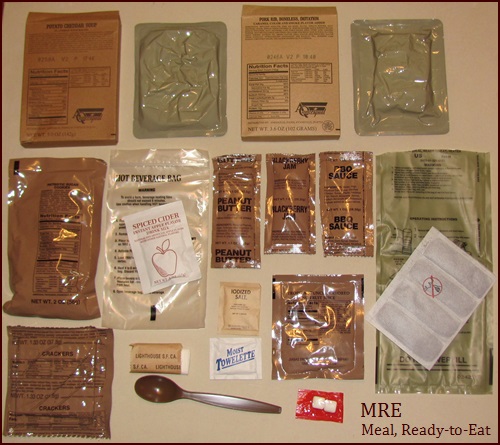
Every so often I hear from a spouse or mother of a soldier serving overseas. They want to know more about dehydrating healthy meals to send them. I’m happy to share dehydrating instructions and recipes as well as vacuum sealing tips. One way I do that is by documenting the process I go through when preparing for a backpacking trip. The past few days, I have been dehydrating food for a 6-day hike on the Appalachian Trail through New Jersey. I’ve been posting photos and descriptions of what I am drying daily on the BackpackingChef Facebook page. Even if you are not “on” Facebook, you can still view the posts. Dominique will be hiking with me. Ratatouille is on the menu and some of her other favorites like saffron-mushroom risotto, unstuffed peppers, and a few homemade soups. I’ll send a write-up of the hike when we get back late October.
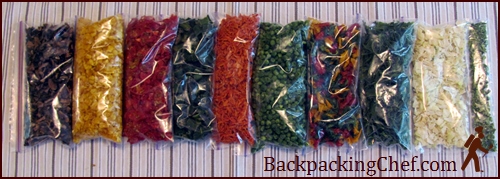
I hope you enjoyed the newsletter. It’s always nice to hear back from you with any comments or suggestions. In this way we have a two-way communication at the well.
Happy Trails until then,

Chef Glenn & Dominique
P.S. If you have any questions or comments about this issue of Trail Bytes, please reply to this email or use the contact form at BackpackingChef.com.
If you received this newsletter from a friend and would like to subscribe (it's free), click here.
Visit my BackpackingChef Facebook page for the lastest posts.


|









